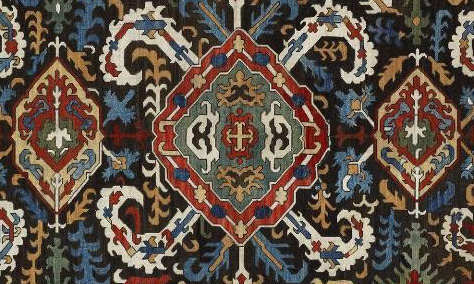by Wendel Swan
The 13th International Conference on Oriental Carpets (ICOC) was held in Washington DC from 6 – 9 August 2015. This edition was scheduled especially to collaborate with and support The Textile Museum’s new location on the campus of George Washington University.
Participants turned out in larger numbers than anticipated and they were treated to many special events. The menu was quite varied and included the important opening exhibition that filled the new museum. Also, three additional exhibitions from private collections, two receptions, two-and-a-half days of lectures, panel discussions and programs (including a Mystery Rug sessions and a show and tell) were on the program. Additionally, access to The Textile Museum’s new conservation and storage facilities and a post-Conference tour to Philadelphia and New York City were heavily attended.
Academic sessions featured international speakers and authorities on new trends in carpet studies, trends in carpet and textile collecting, development in the museum world, the role of the internet and social media in carpet studies and collecting, carpets and contemporary art, as well as various papers on the results of research on specific carpet and textile topics.
An active Carpet Fair in the convenient conference hotel had an international all-star lineup of exhibitors including Seref Ozen, John Collins, Bertram Frauenknecht, James Cohen, Amin Motemedi, Mark Berkovich, Fred Hazin, Adnan Aydin, Mete Mutlu, Rodney McDonald, Ali Aydin, Anatolian Picker, Murathan Ozgen, Douglas Stock, Mohammad Zavvar, Rodolfo Kachanian, Hali magazine, Carpet Collector and Austria Auction Company.
ICOC arranged an exclusive conference rate of $109/night (plus taxes) at the one-year old Hilton Garden Inn, only a 10-minute walk to The Textile Museum.
In addition to the all-encompassing exhibition, “Unraveling Identities” at The Textile Museum, the International Hajji Baba Society mounted an expansive and eclectic exhibition of high-quality rugs and textiles belonging to its members. Virtually every major weaving area was represented to show what Washington area collectors have been acquiring in recent years.
The second exhibition displayed 21 diverse “cushions” from Scandinavia to Central Asia. Included were Turkish yastiks, Belouch balishts and Swedish carriage or seat cushions, in addition to a few extremely rare cushions that were not previously seen outside this exhibition. All were from the 18th and 19th centuries.
In this first known exhibition exclusively of cushions (stuffed textiles that were woven to be leaned against or sat upon as opposed to being storage containers such as bags), participants saw a variety of structures, techniques and color palettes spanning thousands of miles. In some cases, these cushions shared design motifs while retaining their own unique regional identities.
The third exhibition focused on 12 highly collectible niche rugs and textiles from Turkey, Persia and Central Asia. Sometimes referred to as “prayer rugs,” these niche format pieces were variously made of knotted pile, flatwoven kilim, embroidered silk and other weaving techniques.
Wendel Swan, Chair






